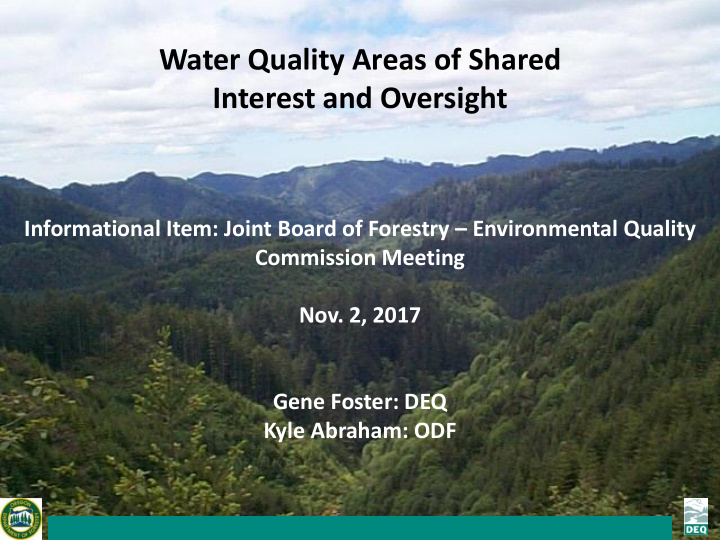



Water Quality Areas of Shared Interest and Oversight Informational Item: Joint Board of Forestry – Environmental Quality Commission Meeting Nov. 2, 2017 Gene Foster: DEQ Kyle Abraham: ODF
Presentation purpose • Review roles and responsibilities for water quality regulation and management on state and private forestlands • Review cooperative mechanisms established by the Oregon Legislature • Summarize on-going forestland water quality work 2
Commission’s role and responsibilities • Implement the federal Clean Water Act and state law (ORS 468B): – Approval of rules including water quality standards – Water Quality permitting system (NPDES, etc) – Nonpoint Source Program (Sect. 319 CWA) – Water Quality Limited waterbodies – TMDLs 3
Board’s role and responsibilities • Supervise all matters of forest policy and management under the jurisdiction of the state …(ORS 526.016) • Under the Forest Practices Act (FPA), continuous growing and harvesting, vest in the Board exclusive authority to adopt and enforce rules governing forest practices (ORS 527.630) 4
Board’s water quality regulatory authority • Board required to adopt best management practices to maintain water quality and meet Commission standards (ORS 527.765) 5
Relationship between Commission & Board • Oregon statutes create a unique cooperative relationship between the Board and the EQC that ensures water quality protection on forestland – The EQC has primary responsibility for complying with the federal Clean Water Act (CWA), and – The BOF has exclusive responsibility for regulating forest practices – Providing each body with a formal process to request that the other consider its concerns 6
Board’s approach to water quality protection • Use of non-regulatory tools. • Efforts under the Oregon Plan for Salmon and Watersheds. • Existing land-use laws to maintain forestland (Statewide Planning Goal 4) • Supports an effective, science-based, and adaptive FPA. 7
Forestry exemption • Unless required to do so by the provisions of the [CWA], neither the [Commission nor the DEQ] shall promulgate or enforce any effluent limitation upon nonpoint source discharges of pollutants resulting from forest operations on forestlands in this state …ORS 468B.110(2) 8
Potential for regulatory conflict • Disagreement over the application of the authorities could result in regulatory conflict – The Commission might believe that the Board has not appropriately applied its BMP authority (ORS 527.765); conversely, – The Board might take issue with the Commission’s water quality standards as they affect forest operations (ORS 468B.105) 9
Cooperative mechanisms • Special procedures govern Board review of existing BMPs • Dialogue expected between the bodies for water quality standards by EQC • Formal liaison roles established in 2013 • Legislative incentive for Board and Commission agreement 10
Cooperative mechanisms • Neither the Board nor Commission has exercised its formal authority to raise disagreements • The petition option in ORS 527.765 has not been exercised by the EQC or the BOF since these laws were passed in 1991 11
Forestland water quality work • Sediment delivery to streams from landslide prone areas and forest roads (CZARA & TMDLs) • Thermal loads following harvest on private forestlands (New Riparian Rule and TMDLs) • Off target migration of pesticides (Monitoring and Pesticide General Permit) • ODF Compliance Audit • ODF Private Forests Monitoring Strategy 12
Questions? 13
Recommend
More recommend